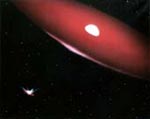Glasgow Astronomers explain hot star disks
Published: 6 November 2002
Astronomers have been puzzled for decades as to how the rings of hot gas surrounding certain types of star are formed.
A team of scientists from the Universities of Glasgow and Wisconsin has studied a type of young, hot star, known as a 'Be' star. This type of star has a disk of glowing gas around it, similar to the rings surrounding Saturn. Until now, no one has been able to account for how these rings form but this research team suggests an answer.
The gas ring surrounding a Be Star may appear and then disappear, possibly reforming at a later time. Material in the disk is attracted back towards the star by the pull of gravity, but if it has enough energy it can escape into space, contributing to the stellar wind. The new theory reveals why this material is held in a disk at some distance from the star instead of either being pulled closer or flying away into space.
Deborah Telfer of Glasgow University explains 'Our model relies on the existence of a magnetic field around Be stars producing a 'MagneticallyTorqued Disk'. Magnetic field lines channel stellar wind material leaving the surface of the star down towards the equatorial plane. A disk then forms in the region where particles have sufficient angular velocity to balance gravity. In the outer regions, the weaker magnetic field lines should burst open allowing particles to form part of the general stellar wind.'
Deborah has been working with Joseph Cassinelli of Wisconsin on the new model for Be star disks and they are delighted with the success of their results.
Deborah added, 'Our findings suggest that only a narrow range of star types could form a detectable Magnetically Torqued Disk and appear as 'Be stars'. Heavier stars would require an unreasonably large magnetic field while lighter stars would produce disks too small to be detected. More work is needed to explain every aspect of observational evidence but we may finally be reaching an understanding of what produces these Saturn-like stars.'
Media Relations Office (media@gla.ac.uk)
This work appeared in the Astrophysical Journal, October 20th 2002, 'A Magnetically Torqued Disk Model for Be Stars' Authors: J. P. Cassinelli (University of Wisconsin-Madison), J. C. Brown (University of Glasgow), M. Maheswaran (University of Wisconsin), N. A. Miller (University of Wisconsin) and D. C. Telfer (University of Glasgow)
Artist's impression
Taken from the perspective of one of the Hubble Space Telescope observations of Phi Persei, this artist's depiction provides a taste of the double- star system's unstable existence.
The bright 'Be' star - a type of hot star with a broad, flattened disk - is the white, semicircular object looming in the upper right of the illustration. The red, pancake-shaped object surrounding the star is a gas disk. The small, hot subdwarf is in the lower left of the illustration. The blasts of white light represent particles of material - called a stellar wind - being released by the star. The red ring of material surrounding the subdwarf was probably formed from the 'Be' star's outflow of gas. The subdwarf is moving toward the right in its 126-day orbit around the 'Be' star. Illustration copyright of Bill Pounds
Deborah Telfer is in the final year of her Ph.D. in stellar physics at Glasgow University.
Contact Details
Deborah Telfer, Dept of Physics & Astronomy
deborah@astro.gla.ac.uk
Tel: 0141 330 5182
First published: 6 November 2002
<< November


